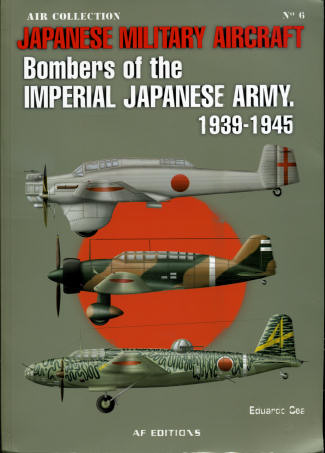 It is not
often that I get to read a book about the Japanese military during WWII and
even less often when that book is published in Spain. Yet here is a superb
book covering IJAAF bombers as used during WWII and before. Little has been
written in the West about these aircraft or the use of them during this time
period. Even less has been produced about the units that flew them. To many
of us, these were just interesting planes with equally interesting, but
generally undecipherable tail markings.
It is not
often that I get to read a book about the Japanese military during WWII and
even less often when that book is published in Spain. Yet here is a superb
book covering IJAAF bombers as used during WWII and before. Little has been
written in the West about these aircraft or the use of them during this time
period. Even less has been produced about the units that flew them. To many
of us, these were just interesting planes with equally interesting, but
generally undecipherable tail markings.Now that is not a problem, thanks to this history and profiles book by Eduardo Cea. Not only are all the units listed by Sentai number, but there are copious full color profiles showing not only the aircraft, but also the evolution of their tail markings. This frequently includes the markings used by the different Chutais within a Sentai.
The author starts with a general history of aviation in Japan, starting with balloons and them moving onto powered flight. As in other nations, the military became interested, mostly in relation to reconnaissance, but moving into other roles just as in the West.
A very nicely done set of charts is provided showing all army aircraft by the long name (Type 95 Fighter), short name (Ki-10), a nickname if appropriate, and also by Allied Code Name (Perry), also if appropriate. This is a very useful chart for the enthusiast and is divided by aircraft mission.
We then go into a relatively long historical section that provides not only a history of Japan's various military engagements from the 1930s to the start of the Pacific War, but also any changes in the order of battle.
Then we get into the meat of the book. Here each Sentai is listed alphabetically. Provided are the aircraft it flew and when it changed airframes. It also provides a description of the unit's tail markings. Not only that, but a look at the unit's movements and some if its missions through the war are provided. Some of these units were extant from before the war to the very end, while others were short lived and still others morphed into different units, flying other types.
Not only just bomber units are covered as it seems that both recon and bombing missions were carried out by these units. It is not unusual to find a unit that flew both types or some that were strictly recon units. When the unit converted to something different, like fighters, then the history of that unit ends.
Despite being well translated from Spanish, I did find a few errors, something that would be common if the translator was not an enthusiast. For instance, the Ki-10 'Perry' is frequently called 'Sperry'. Nothing major, but it does happen from time to time.
In all, it is an outstanding book that is very much a 'must have' for those who have an interest in Japanese WWII types, and especially modelers. This one is most highly recommended.